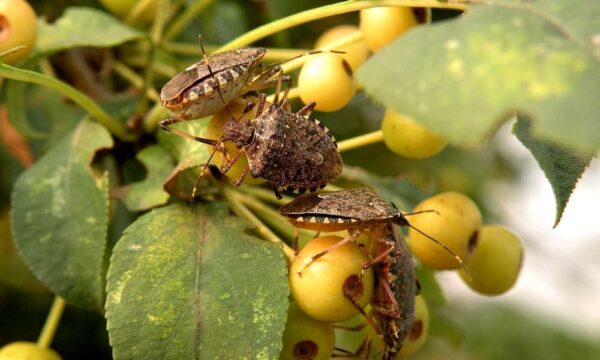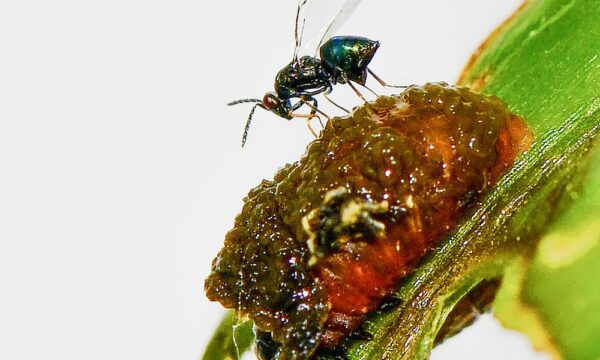
CABI joined a team of international scientists who sought to assess the distribution of natural enemies to control the brown marmorated stink bug (Halyomorpha halys) fruit and nut pest as part of a large-scale monitoring program across in northern Italy and parts of Switzerland.
Dr Tim Haye, who is based at CABI Switzerland, collaborated with researchers from Italy and Switzerland who found that two of the most promising candidates of biocontrol – Trissolcus japonicus (Asian Samurai Wasp) and Trissolcus mitsukurii – have spread to all types of habitats where the stink bug is present.
The study, published in the journal Insects, also provided data which was pivotal in the development of the first release of Tr. japonicus in Europe to control the brown marmorated stink bug which – native to eastern Asia – is able to feed on over 120 different host plants including hazelnuts.
To assess the distribution and abundance of Tr. japonicus and Tr. mitsukurii, the scientists conducted a survey, from May to September 2019, within four years after they were first detected in Europe. Both species showed high levels of parasitism rate towards H. Halys but the parasitism of non-target native species was a rare event.
The generalist Anastatus bifasciatus was the predominant native parasitoid of H. halys, while the emergence of native scelionids from H. halys eggs was rarely observed. The presence of the hyperparasitoid Acroclisoides sinicus was also recorded by the researchers.

Dr Haye said, “This study suggests that both parasitoid species offer promising natural enemy controls for the brown marmorated stink bug without having a detrimental impact upon other native non-target species.
“Sustainable agriculture – particularly with a focus on crop pest and disease control as part of Integrated Pest Management (IPM) plans – can only be achieved through the long-term development of biocontrol methods.
“Accordingly, these require the ongoing support of local and central governments, the scientific community and members of the public.”
Additional information
Main image: Trissolcus parasitoids attack the eggs of the brown marmorated stink bug (Halyomorpha halys) (Credit: Tim Haye, CABI).
Full paper reference
Zapponi, L.; Tortorici, F.; Anfora, G.; Bardella, S.; Bariselli, M.; Benvenuto, L.; Bernardinelli, I.; Butturini, A.; Caruso, S.; Colla, R.; Costi, E.; Culatti, P.; Di Bella, E.; Falagiarda, M.; Giovannini, L.; Haye, T.; Maistrello, L.; Malossini, G.; Marazzi, C.; Marianelli, L.; Mele, A.; Michelon, L.; Moraglio, S.T.; Pozzebon, A.; Preti, M.; Salvetti, M.; Scaccini, D.; Schmidt, S.; Szalatnay, D.; Roversi, P.F.; Tavella, L.; Tommasini, M.G.; Vaccari, G.; Zandigiacomo, P.; Sabbatini-Peverieri, G. Assessing the Distribution of Exotic Egg Parasitoids of Halyomorpha halys in Europe with a Large-Scale Monitoring Program. Insects 2021, 12, 316. https://doi.org/10.3390/insects12040316
Funding acknowledgement
This work was supported by the project “Salvaolivi” grant number DM 0033437 21/12/2017 for CREA; the Swiss Federal Office for the Environment (contract no. 00. 5005. PZ/S084-0191) and with core financial support from CABI’s member countries; the Regione Veneto U.O. Fitosanitario for UniPD; Fondazione Cassa di Risparmio di Cuneo (project HALY-END) and Regione Piemonte (project BIOHALY) for UniTO.
Related publications
Haye, T. and Weber, D. (2017) Special issue on the brown marmorated stink bug, Halyomorpha halys: an emerging pest of global concern. Journal of Pest Science.
Stahl, J. et al. (2017) Using the egg parasitoid Anastatus bifasciatus against the invasive brown marmorated stink bug in Europe: can non-target effects be ruled out? Journal of Pest Science.
Zhang, J. et al. (2017) Seasonal parasitism and host specificity of Trissolcus japonicus in northern China. Journal of Pest Science.
Mason, P.G. and Gillespie, D.R. (eds) (2013) Biological Control Programmes in Canada 2001-2012. CABI.
Project page
Read the project page ‘Biological control of the brown marmorated stink bug’ to find out more about how Dr Haye is leading research** into using Asian or European natural enemies to control the fruit and nut pest.
**Note: this research was funded by Agriculture & Agri-Food Canada, European Commission and Ferrero. Partners include Agriculture and Agri-Food Canada and the University of Torino.
Relevant news stories
CABI supports first release in Switzerland of natural enemy for the brown marmorated stink bug
CABI shares expertise on brown marmorated stink bug which threatens 70% of world’s hazelnut supply
Related News & Blogs
Biological control in action: Zambia’s field days on fighting fall armyworm
Experts from CABI recently held two field days and an expo in Zambia, showcasing innovative approaches to pest management to 584 farmers, agro-dealers and other stakeholders to help raise awareness of approaches to tackle the invasive fall armyworm (Sp…
11 June 2025




